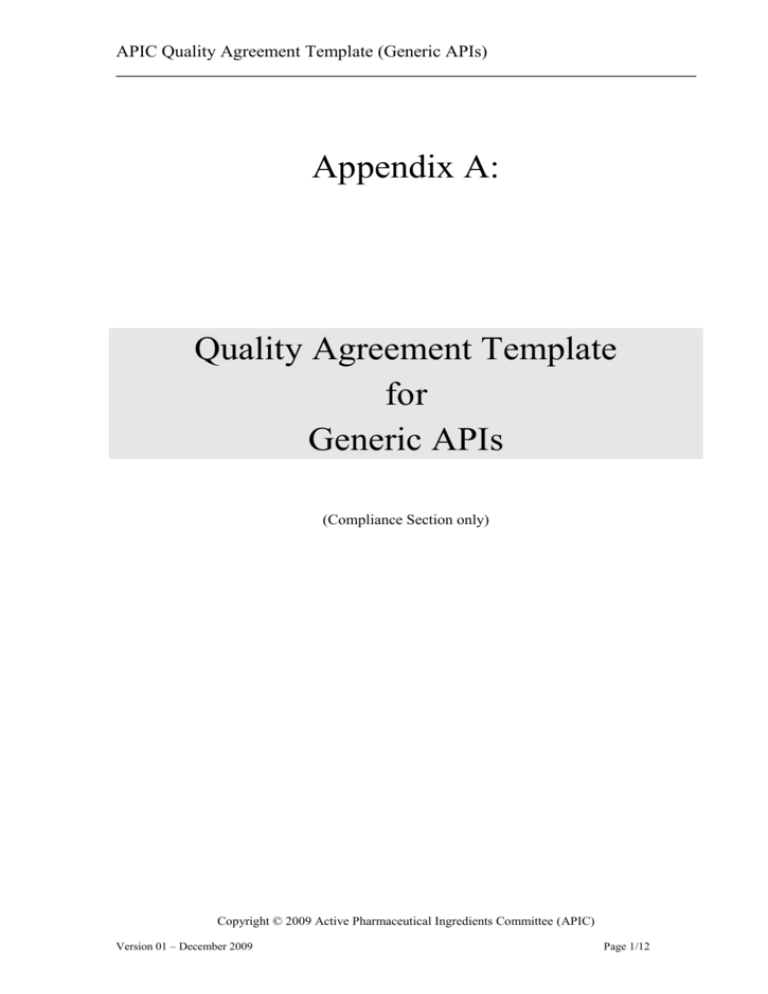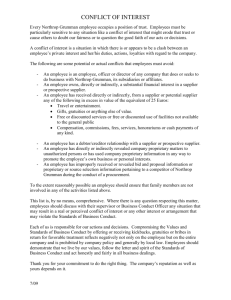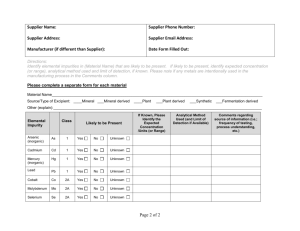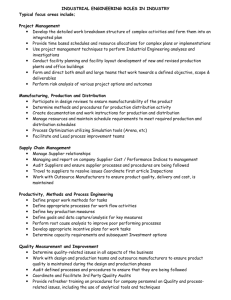Quality Agreement Template (exclusive APIs)
advertisement

APIC Quality Agreement Template (Generic APIs) ___________________________________________________________________________ Appendix A: Quality Agreement Template for Generic APIs (Compliance Section only) Copyright © 2009 Active Pharmaceutical Ingredients Committee (APIC) Version 01 – December 2009 Page 1/12 APIC Quality Agreement Template (Generic APIs) ___________________________________________________________________________ Note 0.1: the term “generic API” is used in this template for all APIs that in principle can be obtained from multiple sources, or are manufactured and supplied to multiple customers, as opposed to APIs that are sold only by the originator company or its exclusive licensees. Such generic APIs are off-patent; they are usually described in pharmacopoeial monographs, and supplied based on standard specifications. 1. Applicable GMP Standard SUPPLIER shall manufacture the SUBSTANCE(s) listed in Appendix X in compliance with the ICH Q7 Guide. 2. Certificate of Analysis / Conformance (optional) A Certificate of Analysis and a Certificate of Conformance (optional) are required for each batch of SUBSTANCE shipped to CUSTOMER. The Certificates of Analysis and Conformance (optional) shall be dated and signed by a responsible person of the SUPPLIER’s Quality Unit, or it may be produced by a computer system which provides a degree of control equivalent to that given by a signature. The Certificate of Analysis states that the batch is suitable for release, and it must include – as a minimum – SUPPLIER name and address, incl. telephone number Name and address of original manufacturer, if SUPPLIER is not the original manufacturer SUBSTANCE name and grade (if applicable), SUPPLIER batch/lot number, Reference to the agreed specification, Test parameters and corresponding specification requirements, Test results (numerical, where applicable) for each chemical, physical or microbiological test performed, Date of release and expiration or retest date Note 2.1: the date of manufacture is considered as optional. of the SUBSTANCE. Optional: The Certificate of Conformance states that the subject lot was produced in accordance to the applicable DMF, CEP or pharmacopoeial monograph(s), and in compliance with all applicable cGMP requirements. Certificate of Analysis and Certificate of Conformance may be issued as separate documents or combined to a single document, as appropriate. Note 2.2: the Certificate of Analysis may be attached as an appendix; in any case it should match the SUBSTANCE specification. Copyright © 2009 Active Pharmaceutical Ingredients Committee (APIC) Version 01 – December 2009 Page 2/12 APIC Quality Agreement Template (Generic APIs) ___________________________________________________________________________ 3. Change Control SUPPLIER shall have a documented and effective change control system in place. SUPPLIER shall inform CUSTOMER of any significant changes to the manufacture of the SUBSTANCE, which may have an impact on the quality of supplied SUBSTANCE, and/or on any regulatory applications related to the SUBSTANCE. SUPPLIER shall notify CUSTOMER within a reasonable time, prior to implementation, to allow CUSTOMER to assess the potential impact of the change upon the SUBSTANCE supplied or its use by CUSTOMER. The implementation of major changes (i.e., changes requiring authorities’ pre-approval) shall not occur until the CUSTOMER has given written approval. SUPPLIER shall only supply CUSTOMER with SUBSTANCE approved under any applicable DMF and/or CUSTOMER's existing regulatory filings until such time as the SUBSTANCE manufactured following such change is permitted under the regulatory filings therefore. For those changes required to comply with applicable laws and regulatory agency requirements, SUPPLIER shall notify CUSTOMER of such requirements after SUPPLIER becomes aware of the need for such change. CUSTOMER undertakes to submit within a reasonable period of time all necessary change notifications to all competent authorities in full compliance with the applicable regulations, respectively, and to inform SUPPLIER of the receipt of the necessary acknowledgement of the validity of the notification and, depending on the type of change, the acceptance or approval of the change by the competent authorities. 4. Right to Audit SUPPLIER shall allow –upon signature of a special confidentiality agreement– CUSTOMER or its representatives to carry out on-site audits by appointment. SUPPLIER shall permit all reasonable access to the manufacturing, packaging, warehousing and laboratory areas related to the manufacture of the SUBSTANCE(s), including pertinent documentation. Any such audit shall take place during normal business hours and must not interfere with SUPPLIER’s manufacturing operations. The results of the audit and the observation(s) shall be sent to SUPPLIER by means of a written report. SUPPLIER must ensure a satisfactory follow up to the observations made during the audit performed by the CUSTOMER, and take corrective actions mutually agreed upon by the parties. Note 4.1: target timelines for both report and response may be added; a 4-weeks period is quite common, respectively. The audit frequency shall depend upon the results of the previous audit(s) and the quality performance of SUPPLIER. In the absence of critical quality incidents the frequency shall be not more than once every three (3) years. 5. Authority Inspections SUPPLIER shall promptly notify CUSTOMER of any regulatory or cGMP violations (e.g. FDA Warning Letter or suspension/withdrawal of one or more CEPs) identified during Copyright © 2009 Active Pharmaceutical Ingredients Committee (APIC) Version 01 – December 2009 Page 3/12 APIC Quality Agreement Template (Generic APIs) ___________________________________________________________________________ authority cGMP inspections and impacting the quality of the SUBSTANCE intended to be shipped to CUSTOMER and/or potentially affecting the ability of SUPPLIER to produce or ship the SUBSTANCE. 6. Sub-contracting SUPPLIER will use its established cGMP systems for evaluation, approval and maintenance of all sub-contracted services with a cGMP impact on SUBSTANCE manufactured. SUPPLIER shall notify CUSTOMER of any existing or new sub-contractor used for any cGMP-relevant service if the regulatory filings of the SUBSTANCE are concerned. 7. Retention of samples (final SUBSTANCE) Note 7.1: one of the two conditions given below should be chosen, depending if an expiry date or a retest date has been defined for the SUBSTANCE. SUPPLIER will store SUBSTANCE retention samples, sufficient to perform at least two (2) full specification analyses (see Note 7.2), in containers that are equivalent to or more protective than the commercial packaging. Samples are to be retained for < one (1) year after the expiry date of the batch assigned by SUPPLIER or for three (3) years after distribution, which ever is the longer > or < for three (3) years after the batch is completely distributed by SUPPLIER >. Note 7.2: “specification analysis” means “analysis according to the agreed specification” that may be identical with “compendial analysis” (if specification is equivalent to current pharmacopoeial monograph), or different in case there is no pharmacopoeial monograph, or if the agreed specification exceeds the monograph. 8. Retention of records/documentation Note 8.1: one of the two conditions given in 8.1 should be chosen, depending if an expiry date or a retest date has been defined for the SUBSTANCE. 8.1 SUPPLIER will store the original master batch records, the executed batch records, and all other original documentation that is related to the manufacture of substance and that is required to be maintained under cGMP, protected from destruction and unauthorised access, for < one (1) year after the expiry date of the batch assigned by SUPPLIER or for three (3) years after distribution, which ever is the longer > or < for three (3) years after the batch is completely distributed by SUPPLIER >. 8.2 SUPPLIER will make the original records related to the manufacture of the SUBSTANCE available for CUSTOMER during an on-site audit. 8.3 Validation documents should be archived for as long as SUBSTANCE is supplied or for 7 years after the version became obsolete. Note 8.2: a period of 7 years is recommended by the APIC “How to do” Document on the ICH Q7 guideline. A 10 years period is also often used. Copyright © 2009 Active Pharmaceutical Ingredients Committee (APIC) Version 01 – December 2009 Page 4/12 APIC Quality Agreement Template (Generic APIs) ___________________________________________________________________________ 9. Stability SUPPLIER has assigned retest dates (or expiry dates, where applicable), storage and shipping conditions, based upon stability studies. SUPPLIER is responsible for performing on-going stability studies for the SUBSTANCE. At least one batch per year should be tested to ICH requirements (long-term storage conditions only). Note 9.1: in case the SUBSTANCE is not manufactured in a certain year the above requirement is not applicable. SUPPLIER is responsible for performing appropriate stability studies on the SUBSTANCE arising from process changes. SUPPLIER will provide stability data to CUSTOMER upon reasonable request (e.g., if required according to the applied registration procedure). Note 9.2: Results of the on-going stability program are not routinely provided to customers. 10. Complaints SUPPLIER will respond to complaints by the CUSTOMER in a timely manner and according to formally agreed procedures. SUPPLIER will inform CUSTOMER in a timely manner and in writing on the conclusions driven by the investigation performed and the corrective/preventive actions defined. In case the investigation could not be finalized within 20 business days, SUPPLIER will provide an interim report to CUSTOMER. Note 10.1: target timelines for both initial and concluding responses may be added; for the concluding response a period of 20 business days is quite common. CUSTOMER will make relevant information and samples of the affected SUBSTANCE batch(es)/lot(s) available to assist in the investigation of SUPPLIER (as appropriate). SUPPLIER will inform CUSTOMER if any received complaint could also have a serious impact on batches supplied to CUSTOMER (i.e., the complaint constitutes a potential risk to patients’ health or safety). The statutory and/or contractual obligations of CUSTOMER to inspect the goods upon delivery and to promptly notify any defect or shortage remain unaffected. 11. Recall Immediately after SUPPLIER has become aware of it, SUPPLIER will inform CUSTOMER of any serious quality issue that may result in a recall of supplied SUBSTANCE or finished drug product made thereof. SUPPLIER and CUSTOMER consult and decide on roles and responsibilities regarding coordination of the investigation and decisions. CUSTOMER is responsible for the final decision and the coordination of any recalls or field alert activities related to finished drug product, whereas SUPPLIER shall not be prohibited Copyright © 2009 Active Pharmaceutical Ingredients Committee (APIC) Version 01 – December 2009 Page 5/12 APIC Quality Agreement Template (Generic APIs) ___________________________________________________________________________ hereunder from taking any action that is deemed necessary based on science and risk or that is required to be taken by applicable law. 12. Product quality review SUPPLIER shall allow CUSTOMER to review the annual Product Quality Review (PQR) for the SUBSTANCE(s) during an on-site audit. 13. Storage and distribution Notes: 13.1: Storage: special storage requirements for the SUBSTANCE(s) should be clear. 13.2: Distribution: either in the Supply Agreement or in the Quality Agreement the responsibilities for the whole supply chain should be defined; reference to GDP (IPEC, WHO) is recommended. The following text is written for a case where the SUPPLIER is responsible for the transportation from the manufacturing site to the CUSTOMER’s receiving site (and needs to be changed, if responsibilities are different). SUPPLIER shall make commercially reasonable efforts to exclude, during packaging, storage, and shipping of the SUBSTANCE(s), the possibility of deterioration, contamination, or mix-ups with any other material. SUPPLIER shall comply with the following requirements in relation to distribution of the SUBSTANCE(s): Distribution in accordance with storage conditions stated on the labels Contracts with hauliers and shipping agents Ability to recall SUBSTANCE from distribution network Quarantine SUBSTANCE with questionable quality Utilise tamper evident seals on all packaging SUPPLIER will qualify hauliers and shipping agents used to transport the SUBSTANCE(s). SUPPLIER will provide an up-to-date MSDS to CUSTOMER with each shipment or at least on an annual basis. This agreement does not absolve the SUPPLIER from complying with any legal requirements in relation to the transportation of the SUBSTANCE(s). 14. Undesirable contaminants Note 14.1: the three items listed below constitute the most frequently requested ones. Others may be added as appropriate. 14.1 BSE/TSE Copyright © 2009 Active Pharmaceutical Ingredients Committee (APIC) Version 01 – December 2009 Page 6/12 APIC Quality Agreement Template (Generic APIs) ___________________________________________________________________________ SUPPLIER shall provide to CUSTOMER a BSE/TSE certificate for the SUBSTANCE(s) listed in accordance with the EMEA Note for Guidance EMEA/410/01 (current revision). The certificate shall indicate if the SUBSTANCE(s) is (are) of human or animal origin, and if materials of human or animal origin are used during the manufacturing process of the SUBSTANCE (s). An updated BSE/TSE certificate must be issued after any change to the manufacturing process which involves new raw materials or for raw materials that have been sourced from a different supplier. 14.2 Residual solvents SUPPLIER shall provide to CUSTOMER a residual solvents statement for the SUBSTANCE(s) listed in accordance with the ICH Q3C guideline. An updated statement must be issued after changes to the manufacture of the SUBSTANCE(s), if applicable. 14.3 Metal catalyst/reagent residues SUPPLIER shall provide to CUSTOMER a statement on metal residues for the SUBSTANCE(s) listed in accordance with the EMEA “Guideline on the specification limits for residues of metal catalysts or metal reagents” (EMEA/ CHMP/ SWP/ 4446/ 2000) and other applicable regulations. An updated statement must be issued after changes to the manufacture of the SUBSTANCE(s), if applicable. If the CEP contains the required information on BSE/TSE, residual solvents or metal catalyst/reagent residues, then the CEP itself may be used instead of separate supplier declarations. 15. HAPIs 15.1 SUPPLIER shall not conduct production and handling of highly sensitizing materials (such as penicillins or cephalosporins) in the equipment being used for the SUBSTANCE(s). Production of such materials in the same building being used for the SUBSTANCE(s) is permitted only if performed in a closed and dedicated system. 15.2 In case of highly active or toxic materials, such as potent hormones, cytotoxic compounds, or other potentially hazardous materials manufactured by the SUPPLIER in the same facilities as used for SUBSTANCE, validated inactivation and/or cleaning procedures should be in place. 16. Raw materials N/A 17. Qualification / Validation N/A Note 17.1: qualification and validation activities according ICH Q7, chapter 12; not necessary to give more details in the agreement. Copyright © 2009 Active Pharmaceutical Ingredients Committee (APIC) Version 01 – December 2009 Page 7/12 APIC Quality Agreement Template (Generic APIs) ___________________________________________________________________________ 18. Reprocessing N/A Note 18.1: not to be included in the agreement; reprocessing shall be performed according to the registration dossier and ICH Q7, chapter 14.2. No further information on reprocessing necessary as far as described in the DMF or CEP dossier (generic APIs). If ICH Q7 as well as the registered procedures are followed there is actually no justified reason to refuse the delivery of reprocessed batches of SUBSTANCE. 19. Reworking Reworking must be performed, if at all, according to the SUBSTANCE registration documents, if it is part of the dossier, or according to ICH Q7, chapter 14.3. CUSTOMER should be informed of such batches/lots. Note 19.1: on agreement reworking might be prohibited. 20. Deviations / OOS (incl. stability) In case of serious quality incidents observed only after shipment of batches of the SUBSTANCE, SUPPLIER shall promptly and appropriately notify CUSTOMER thereof. Note 20.1: information on OOS results in stability is only necessary if there is an impact on the retest period or the storage condition or the packaging material (such information would be given through a change control procedure anyway; see also section 3). 21. Packaging In addition to the requirements in ICH Q7 the following shall apply to the packaging of the SUBSTANCE(s): The specifications for packaging materials including tamper evident seals must be in accordance with the regulatory documentation related to the SUBSTANCE(s). Optional: SUPPLIER shall package the SUBSTANCE using the components, closures and tamper evident seals as specified in Appendix X. Note 21.1: the list in Appendix X may include both primary packaging materials and secondary ones, e.g. pallets, wrapping etc. There may be the need to define and explain any coding on the seals. < List other security measures here, as applicable. > Note 21.2: the following paragraph is only applicable in very specific cases. Optional: When primary packaging material is returned from CUSTOMER to SUPPLIER for reuse, SUPPLIER will validate the cleaning procedure(s) used to clean the packaging material. Copyright © 2009 Active Pharmaceutical Ingredients Committee (APIC) Version 01 – December 2009 Page 8/12 APIC Quality Agreement Template (Generic APIs) ___________________________________________________________________________ 22. Labelling N/A Notes: 22.1: the shipping label may include additional information (e.g., CUSTOMER material code); details may be defined in the Supply Agreement; 22.2: labelling should be described in sufficient detail if done on behalf of the CUSTOMER; 22.3: an example of the label may be provided in an appendix to the Quality Agreement. 23. Regulatory documents SUPPLIER is responsible for preparation, submission and maintaining the appropriate registration documents for the SUBSTANCE (i.e. dossier for CEP, DMF, or equivalent). SUPPLIER is responsible for all regulatory contacts with the relevant regulatory authority with jurisdiction over the SUBSTANCE. Upon written request, SUPPLIER will allow CUSTOMER to refer to SUPPLIER’s registration documents for the SUBSTANCE, in order to support CUSTOMER’s Marketing Authorisation Applications for finished drug product made from SUBSTANCE. SUPPLIER will provide current information to CUSTOMER, as reasonably requested for the SUBSTANCE by guidance for submission of any regulatory dossier by CUSTOMER for finished drug product made from SUBSTANCE. Such information will include either access to CEP (including the appropriate stability data for the SUBSTANCE, if no retest date is defined in the CEP), or applicants part to DMF, or equivalent. CUSTOMER is responsible for submitting the regulatory dossier for Marketing Authorisation Application associated with any finished drug products made from the SUBSTANCE. Such regulatory dossier, as it pertains to SUPPLIER, will refer to SUPPLIER’s CEP, DMF or equivalent, where applicable. Optional: Appendix X will include the list of SUPPLIER’s supportive registration documents that are available at the signature of this Quality Agreement. 24. Product release Optional: SUPPLIER will not ship any SUBSTANCE to CUSTOMER until the SUBSTANCE is released, unless prior written approval has been received from CUSTOMER to perform such a shipment under quarantine. 25. Reference standards All reference standards should be stored in accordance with the suppliers recommended storage conditions and used within their given expiry or retest date. Copyright © 2009 Active Pharmaceutical Ingredients Committee (APIC) Version 01 – December 2009 Page 9/12 APIC Quality Agreement Template (Generic APIs) ___________________________________________________________________________ SUPPLIER shall provide to CUSTOMER reasonable quantities of any non-compendial, commercially not available reference standards necessary to perform the tests included in the SUBSTANCE specification. 26. Specifications Specifications for the SUBSTANCE(s) are detailed in Appendix X. 27. Analytical methods SUPPLIER shall provide to CUSTOMER any in-house methods, including validation reports, used for testing according to the agreed specifications (where there are no compendial methods). Compendial analytical methods must be verified and all others must be validated prior to use. Copyright © 2009 Active Pharmaceutical Ingredients Committee (APIC) Version 01 – December 2009 Page 10/12 APIC Quality Agreement Template (Generic APIs) ___________________________________________________________________________ Annex: Division of Responsibilities [ C = CUSTOMER; S = SUPPLIER ] A Regulatory Compliance C S X X 1. Adhere to approved registration documentation (Marketing Authorisation, NDA, IND, DMF, CEP, etc, as applicable) 2. Maintaining valid manufacturing license(s), as applicable X 3. Maintaining site master file, as applicable X 4. Inform on significant changes X 5. Submitting change notifications/applications to authorities X B Purchasing, Manufacturing and Analytical Testing of API Starting Materials (SMs), Raw Materials, Process Aids, Intermediates, and SUBSTANCE 6. Setting specifications for SUBSTANCE, materials and intermediates X 7. Purchasing materials according to specifications X 8. Qualifying and monitoring material suppliers X 9. Sampling and testing of incoming material, as appropriate X 10. Generating and approving Master Batch Procedure/Record X 11. Manufacturing SUBSTANCE according to Master Batch Procedure (incl reprocessing, packaging, labelling) X 12. Performing batch record review X 13. Assigning batch numbers X 14. Sampling, testing, and releasing of intermediates and SUBSTANCE X 15. Performing IPCs X 16. Storing retention samples X 17. Documenting all deviations, investigating OOS and critical deviations X 18. Maintaining (certified) reference standards X C Purchasing and Testing of Packaging Material X D Labelling, Label Printing and Label Reconciliation X E Storage and Shipment 19. Storing API under labelled conditions 20. Maintaining storage conditions during transportation until agreed transition point X X X Copyright © 2009 Active Pharmaceutical Ingredients Committee (APIC) Version 01 – December 2009 Page 11/12 APIC Quality Agreement Template (Generic APIs) ___________________________________________________________________________ F Documentation C S 21. Establishing synthesis scheme (including definition of API SMs) X 22. Archiving the original manufacturing and control documents X 23. Issuing Certificate of Analysis / Certificate of Conformance (optional) X 24. Preparing reports on OOS, critical deviations X 25. Providing test procedures, quality statements, stability reports, and other documents as mutually agreed between the parties X X G Equipment Cleaning H Qualification / Validation 26. Qualifying of equipment, utilities and facilities X 27. Validating the manufacturing process, cleaning procedures, analytical methods, and computerised systems X I Stability Program 28. Performing stability studies, incl on-going stability studies, under ICH conditions (incl testing) 29. Assigning retest period (or shelf-life) X X X X K Product Quality Review L Complaints and Recall 30. Investigating customer complaints related to SUBSTANCE X 31. Implementing corrective actions, if necessary X 32. Responding to customer(s) X 33. Deciding to initiate recall X1) X2) 34. Notifying authorities, external customers, or consumers X1) X2) 35. Clarifying root cause X X 36. Storing or disposing returned product X1) X2) M Sub-Contracting 37. 1) 2) Qualifying and monitoring sub-contractors X Responsibility regarding drug product made from SUBSTANCE Responsibility regarding SUBSTANCE Copyright © 2009 Active Pharmaceutical Ingredients Committee (APIC) Version 01 – December 2009 Page 12/12







